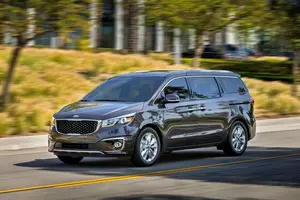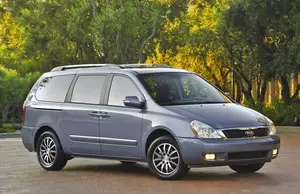
| Vehicle | Precise engine size | Difference from world average | Engine size to consumption ratio | Horsepower from 1 L | Engine size to 100 kg of weight |
|---|---|---|---|---|---|
| 3.3 V6 |
3.34 L (3342 cc) |
42.5% bigger | - | 81 hp from 1 L | - |
| Vehicle | 3.3 V6 |
|---|---|
| Precise engine size | 3.34 L (3342 cc) |
| Difference from world average | 42.5 bigger |
| Engine size to consumption ratio | - |
| Horsepower from 1 L | 81 hp from 1 L |
| Engine size to 100 kg of weight | - |

| Vehicle | Precise engine size | Difference from world average | Engine size to consumption ratio | Horsepower from 1 L | Engine size to 100 kg of weight |
|---|---|---|---|---|---|
| 2.2 CRDi |
2.2 L (2199 cc) |
6.3% smaller | 71 cc to 1 mpg | 91 hp from 1 L | 110 cc to 100 kg |
| 3.3 V6 |
3.34 L (3342 cc) |
42.5% bigger | 159 cc to 1 mpg | 81 hp from 1 L | 167 cc to 100 kg |
| Vehicle | 2.2 CRDi |
|---|---|
| Precise engine size | 2.2 L (2199 cc) |
| Difference from world average | 6.3 smaller |
| Engine size to consumption ratio | 71 cc to 1 mpg |
| Horsepower from 1 L | 91 hp from 1 L |
| Engine size to 100 kg of weight | 110 cc to 100 kg |
| Vehicle | 3.3 V6 |
| Precise engine size | 3.34 L (3342 cc) |
| Difference from world average | 42.5 bigger |
| Engine size to consumption ratio | 159 cc to 1 mpg |
| Horsepower from 1 L | 81 hp from 1 L |
| Engine size to 100 kg of weight | 167 cc to 100 kg |

| Vehicle | Precise engine size | Difference from world average | Engine size to consumption ratio | Horsepower from 1 L | Engine size to 100 kg of weight |
|---|---|---|---|---|---|
| 2.2 E-VGT |
2.2 L (2199 cc) |
6.3% smaller | - | 90 hp from 1 L | 105 cc to 100 kg |
| 3.5 V6 |
3.47 L (3470 cc) |
47.9% bigger | - | 79 hp from 1 L | 165 cc to 100 kg |
| 2.9 CRDi |
2.9 L (2902 cc) |
23.7% bigger | - | 64 hp from 1 L | 138 cc to 100 kg |
| Vehicle | 2.2 E-VGT |
|---|---|
| Precise engine size | 2.2 L (2199 cc) |
| Difference from world average | 6.3 smaller |
| Engine size to consumption ratio | - |
| Horsepower from 1 L | 90 hp from 1 L |
| Engine size to 100 kg of weight | 105 cc to 100 kg |
| Vehicle | 3.5 V6 |
| Precise engine size | 3.47 L (3470 cc) |
| Difference from world average | 47.9 bigger |
| Engine size to consumption ratio | - |
| Horsepower from 1 L | 79 hp from 1 L |
| Engine size to 100 kg of weight | 165 cc to 100 kg |
| Vehicle | 2.9 CRDi |
| Precise engine size | 2.9 L (2902 cc) |
| Difference from world average | 23.7 bigger |
| Engine size to consumption ratio | - |
| Horsepower from 1 L | 64 hp from 1 L |
| Engine size to 100 kg of weight | 138 cc to 100 kg |

| Vehicle | Precise engine size | Difference from world average | Engine size to consumption ratio | Horsepower from 1 L | Engine size to 100 kg of weight |
|---|---|---|---|---|---|
| 2.7 V6 16V |
2.66 L (2656 cc) |
13.2% bigger | 102 cc to 1 mpg | 71 hp from 1 L | 133 cc to 100 kg |
| 2.2 E-VGT |
2.2 L (2199 cc) |
6.3% smaller | - | 90 hp from 1 L | 110 cc to 100 kg |
| 3.8i V6 |
3.78 L (3778 cc) |
61% bigger | - | 67 hp from 1 L | 189 cc to 100 kg |
| Vehicle | 2.7 V6 16V |
|---|---|
| Precise engine size | 2.66 L (2656 cc) |
| Difference from world average | 13.2 bigger |
| Engine size to consumption ratio | 102 cc to 1 mpg |
| Horsepower from 1 L | 71 hp from 1 L |
| Engine size to 100 kg of weight | 133 cc to 100 kg |
| Vehicle | 2.2 E-VGT |
| Precise engine size | 2.2 L (2199 cc) |
| Difference from world average | 6.3 smaller |
| Engine size to consumption ratio | - |
| Horsepower from 1 L | 90 hp from 1 L |
| Engine size to 100 kg of weight | 110 cc to 100 kg |
| Vehicle | 3.8i V6 |
| Precise engine size | 3.78 L (3778 cc) |
| Difference from world average | 61 bigger |
| Engine size to consumption ratio | - |
| Horsepower from 1 L | 67 hp from 1 L |
| Engine size to 100 kg of weight | 189 cc to 100 kg |

| Vehicle | Precise engine size | Difference from world average | Engine size to consumption ratio | Horsepower from 1 L | Engine size to 100 kg of weight |
|---|---|---|---|---|---|
| 2.7i V6 |
2.66 L (2656 cc) |
13.2% bigger | 121 cc to 1 mpg | 71 hp from 1 L | 140 cc to 100 kg |
| 2.9 CRDi |
2.9 L (2902 cc) |
23.7% bigger | 97 cc to 1 mpg | 64 hp from 1 L | 138 cc to 100 kg |
| Vehicle | 2.7i V6 |
|---|---|
| Precise engine size | 2.66 L (2656 cc) |
| Difference from world average | 13.2 bigger |
| Engine size to consumption ratio | 121 cc to 1 mpg |
| Horsepower from 1 L | 71 hp from 1 L |
| Engine size to 100 kg of weight | 140 cc to 100 kg |
| Vehicle | 2.9 CRDi |
| Precise engine size | 2.9 L (2902 cc) |
| Difference from world average | 23.7 bigger |
| Engine size to consumption ratio | 97 cc to 1 mpg |
| Horsepower from 1 L | 64 hp from 1 L |
| Engine size to 100 kg of weight | 138 cc to 100 kg |

| Vehicle | Precise engine size | Difference from world average | Engine size to consumption ratio | Horsepower from 1 L | Engine size to 100 kg of weight |
|---|---|---|---|---|---|
| 2.9 CRDi |
2.9 L (2902 cc) |
23.7% bigger | - | 59 hp from 1 L | 132 cc to 100 kg |
| 3.8 V6 |
3.78 L (3778 cc) |
61% bigger | - | 66 hp from 1 L | 180 cc to 100 kg |
| Vehicle | 2.9 CRDi |
|---|---|
| Precise engine size | 2.9 L (2902 cc) |
| Difference from world average | 23.7 bigger |
| Engine size to consumption ratio | - |
| Horsepower from 1 L | 59 hp from 1 L |
| Engine size to 100 kg of weight | 132 cc to 100 kg |
| Vehicle | 3.8 V6 |
| Precise engine size | 3.78 L (3778 cc) |
| Difference from world average | 61 bigger |
| Engine size to consumption ratio | - |
| Horsepower from 1 L | 66 hp from 1 L |
| Engine size to 100 kg of weight | 180 cc to 100 kg |

| Vehicle | Precise engine size | Difference from world average | Engine size to consumption ratio | Horsepower from 1 L | Engine size to 100 kg of weight |
|---|---|---|---|---|---|
| 2.9 CRDI |
2.9 L (2902 cc) |
23.7% bigger | 100 cc to 1 mpg | 50 hp from 1 L | 138 cc to 100 kg |
| 2.5i V6 24V |
2.5 L (2497 cc) |
6.4% bigger | 114 cc to 1 mpg | 60 hp from 1 L | 131 cc to 100 kg |
| 2.5i V6 |
2.5 L (2497 cc) |
6.4% bigger | 114 cc to 1 mpg | 60 hp from 1 L | 125 cc to 100 kg |
| 2.9 TD |
2.9 L (2902 cc) |
23.7% bigger | - | 45 hp from 1 L | 153 cc to 100 kg |
| Vehicle | 2.9 CRDI |
|---|---|
| Precise engine size | 2.9 L (2902 cc) |
| Difference from world average | 23.7 bigger |
| Engine size to consumption ratio | 100 cc to 1 mpg |
| Horsepower from 1 L | 50 hp from 1 L |
| Engine size to 100 kg of weight | 138 cc to 100 kg |
| Vehicle | 2.5i V6 24V |
| Precise engine size | 2.5 L (2497 cc) |
| Difference from world average | 6.4 bigger |
| Engine size to consumption ratio | 114 cc to 1 mpg |
| Horsepower from 1 L | 60 hp from 1 L |
| Engine size to 100 kg of weight | 131 cc to 100 kg |
| Vehicle | 2.5i V6 |
| Precise engine size | 2.5 L (2497 cc) |
| Difference from world average | 6.4 bigger |
| Engine size to consumption ratio | 114 cc to 1 mpg |
| Horsepower from 1 L | 60 hp from 1 L |
| Engine size to 100 kg of weight | 125 cc to 100 kg |
| Vehicle | 2.9 TD |
| Precise engine size | 2.9 L (2902 cc) |
| Difference from world average | 23.7 bigger |
| Engine size to consumption ratio | - |
| Horsepower from 1 L | 45 hp from 1 L |
| Engine size to 100 kg of weight | 153 cc to 100 kg |

| Vehicle | Precise engine size | Difference from world average | Engine size to consumption ratio | Horsepower from 1 L | Engine size to 100 kg of weight |
|---|---|---|---|---|---|
| 2.9 TD |
2.9 L (2903 cc) |
23.7% bigger | - | 47 hp from 1 L | 153 cc to 100 kg |
| 2.5i V6 24V |
2.5 L (2497 cc) |
6.4% bigger | - | 70 hp from 1 L | 147 cc to 100 kg |
| Vehicle | 2.9 TD |
|---|---|
| Precise engine size | 2.9 L (2903 cc) |
| Difference from world average | 23.7 bigger |
| Engine size to consumption ratio | - |
| Horsepower from 1 L | 47 hp from 1 L |
| Engine size to 100 kg of weight | 153 cc to 100 kg |
| Vehicle | 2.5i V6 24V |
| Precise engine size | 2.5 L (2497 cc) |
| Difference from world average | 6.4 bigger |
| Engine size to consumption ratio | - |
| Horsepower from 1 L | 70 hp from 1 L |
| Engine size to 100 kg of weight | 147 cc to 100 kg |